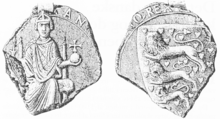The coat of arms of Denmark has three crowned blue lions with nine red hearts, all in a golden shield.


The seal of King Canute VI of Denmark is the oldest known example of the coat of arms of Denmark. It is from around 1190.

Denmark also used to have a greater coat of arms that was also used by the government. It was created in 1819 and adopted by King Frederik VI, but it did change over the years. In 1959, the greater coat of arms became the royal coat of arms, meaning a coat of arms only for the king and the royal family, and other one became the state coat of arms, meaning a coat of arms for the government. In 1972 when King Frederik IX died and Margrethe II became queen, the royal coat of arms was redesigned, and in 2024, King Frederik X changed it again.
Today, the royal coat of arms is made up of symbols representing all the current parts of the Kingdom of Denmark. The top left part of the shield (the three lions) represents Denmark. The top right part (the ram) represents the Faroe Islands. The bottom left part (the polar bear) represents Greenland. The bottom right part (the two lions) represents Southern Jutland. In the centre, there is a shield representing the House of Oldenburg, who are the ancestors of the Danish royal family.